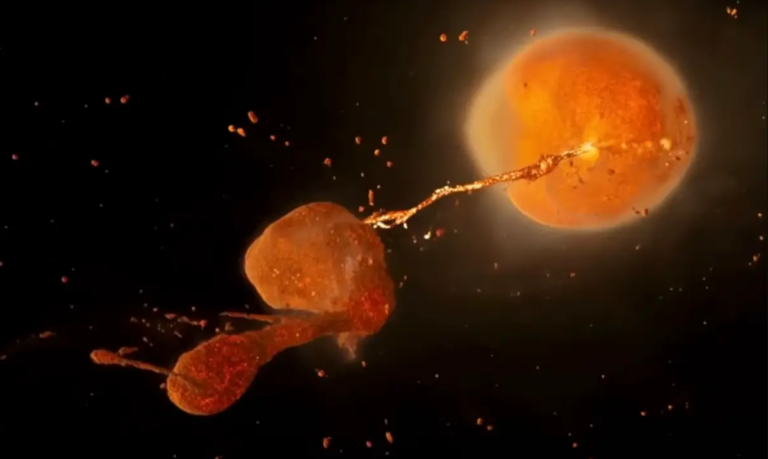A supercomputer simulation has revealed that the moon was formed in a matter of hours following the collision between Theia and Earth.
The moon is Earth’s faithful companion, but once it wasn’t around. Approximately 4. About 5 billion years ago, a Mars sized body named as Theia struck a Moonless Earth. This is regarded to have caused debris in the Earth and after aggregating formed the moon. This theory is also referred to as Giant Impact Hypothesis and it provides how the Moon formed.
Nevertheless, it is necessary to state that there are some issues concerning the Giant Impact Hypothesis, despite the fact that it is perceived to be widely acceptable. These are some of the difficulties which include close resemblance between rocks from the moon and the earth’s mantle. If Apollo astronauts have been able to collect samples of Moon rocks, isotopic analysis of these rocks will show that the isotopic signatures of those rocks are of similar type with the Earth. This has given rise to considerable debate on the probability of the Moon having been made with a substantial part of the material that is found on Earth.
Contrary to the Giant Impact Hypothesis that was mentioned above, as for today, researchers provide new computer simulations from the Institute of Computational Cosmology, Durham University. From these simulations, they suggest that the formation of the Moon could have occurred just after the impact with Theia, maybe within a few hours at most. The consolidation at such a rate gives a new twist to the existing theories of the formation and evolution of the moon.
To say this, lead author Jacob Kegerreis in an interview with NASA said that these discoveries give fresh understanding of the history of the moon . This paper containing these simulations was published in the Astrophysical Journal Letters.
A puzzle of planetary proportions
The impact that Theia had with Earth was modeled by the scientists about 400 times in their numerical models where the technique used was the smoothed particle hydrodynamics. This technique normally applied in impact experiments where it is tough to mimic particles under the pull of gravity and pressure. Earlier attempts at mimicking the process of Moon formation involved several hundred thousand or even a few million particles. Again, these new simulations came with as many as one hundred million particles, which put them among the most complex simulations.
The added computational power showed that using lower resolutions as the parameters can actually result in overlooking certain behaviors that happen during such collisions. “We initiated this project not knowing the real benefits of these high-resolution simulations. ” As said by KegerreisThis discovery would not only continue to reveal that standard resolutions can carry more fallacious information but would be especially flowing with the new findings that could ultimately yield a Moon like satellite in orbit.
Having adopted the direct-formation simulations, the team was able to come up with a Moon with a large orbit with partial melting of the interior. These characteristics may speak volumes about the angle of lunar orbit and the crust, which is thinner than the Martian one.
Although the models are interesting, they do not address all aspects that are considered to be true about the Moon up to date. Especially, the simulations formed a Moon that has a 60% Earth-like material composition. But this cannot on its own accounts for what appears as quite comparable isotopic ratios between the Earth and the Moon.
In this, the authors argue that if there was 60% of protoEarth material and 40% of Theia, it should give much higher terrestrial isotopic ratio than the Earth-Moon values observed. But as the article pointed out, it is feasible that the material from Theia and Earth may not had fully been incorporated in the rapidly developing Moon but there is a layer of the Earth like material just below the surface and this is something that Canup does not concur with. “Thus, if a part of the Moon remained undamaged in its formation, the protolunar and the post-impact material cannot be mixed such that the composition contrast is entirely removed. ”
Looking forward
NASA should continue to study lunar rocks coming from other unexplored areas on the Moon to reveal more information on its birth. These are some of the research areas that can be realized with NASA’s subsequent Artemis missions. The scientific fraternity is also concerned with collection of samples from below the Moon’s surface. According to theorists, who combine one or the other models, it is possible to open the secret of how the Moon has been formed along with the Early Earth 4. 5 billion years ago.
Furthermore, many questions about our celestial neighbor will be answered; and in answering these questions new information about our own Earth will be discovered.
Vincent Eke, a researcher at Durham University and co-author of the study, said, “The investigations into the origin of the Moon to helps in understanding the evolution of the Earth and the storyline of any other facilitative celestial bodies.
Do not forget to share your opinion with us to provide you with the best posts !




0 Comments